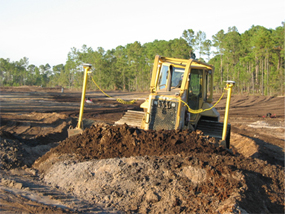The Prairie Highlands Golf Research Library at Schreiner Golf, Inc. headquarters is located just off the main office. It houses close to 3,000 volumes and is one of the largest in the Mid-west. It is a tremendous resource for historic and architectural research. The history of golf is very important. Knowing the evolution of the sport and specific golf clubs has a direct impact on renovation and restoration work. Educating people about how many successful courses evolved is a part of providing professional service. Information can help "decision makers" more comfortable about the implementation process.
Club histories can make the chronology of a facility clearer and help to build bridges that are needed to renovate and restore certain courses. Having a large library is very helpful and enriches the way in which we conduct or approach certain projects. Understanding the past is a great basis to implement future improvements.
Our collection of original plans, replications of same and vast array of rare books on golf course architecture help us communicate the evolution of a facility regarding the bunkering, greens and even original routing.
 The Headquarters of the Schreiner is located in the clubhouse of Prairie
Highlands along with the Prairie Highlands Golf Research Library.
The Headquarters of the Schreiner is located in the clubhouse of Prairie
Highlands along with the Prairie Highlands Golf Research Library.
The library also includes many volumes on green keeping, turfgrass science, USGA Green Reports dating back to the early twenties and other British Journals of golf course maintenance. These are interesting resources which can shed light on the evolution of golf course maintenance and how the industry has progressed.
As a daily fee facility, PHGC is a laboratory, which allows us to constantly review or design as it relates to daily operations and hosting events. The NAIA has held its national collegiate tournament here for the last two years and with great success. The event hosts some sixty teams from around the country and the course is challenged by some of the best young golfers in America. That allows Schreiner Golf, Inc. to analyze the course while the lowest of handicap players try to score on it.
The latest technology has enabled Schreiner Golf, Inc. to keep on top of accurate drawing production and the transmission of information through the internet. Our drafting and engineering software, MicroStation® helps us to communicate and quantify all aspects of the golf course design process. We work to define each segment of the design process via individual drawings and link them together with accuracy and consistency. Each set of working drawings can be electronically transmitted anywhere in the world and printed as a PDF file at most modern printing outlets such as FedEx Kinko's. Our quantification of the line items normally bid on by golf course contractors is accurate and consistent.
Once the grading plans are entered into the software, they can be downloaded to GPS driven programs that can actually replicate the plan on the site. The construction of the Grande Dunes Members Club in Myrtle Beach, South Carolina was graded by GPS equipped dozers that carved the course out of the site via direct linkage to the grading plan. Staking and other traditional means of golf course construction were not necessary because the operator on the lead bulldozer was working from the grading plan as it was being downloaded to his dozer!
This approach to construction is so efficient that staking is almost entirely eliminated and rough grading is refined to a level of accuracy that was never possible in such a quick time.
Craig Schreiner is a subscriber to the Turfgrass Information Center at Michigan State University. This data center is a resource accessible via the internet. It hosts millions of articles, facts, statistics, photos and other forms of information regarding turfgrass science. It is a tremendous resource that can be utilized at any time from most anywhere. Craig has always sponsored and supported research in the golf course industry and continues to stay in touch with new developments in seed and soil science.
Craig is also a Committee Member of the Strategic Communications Committee of the GCSAA. He has been an active participant at meetings and in the development of ideas for the advancement of the GCSAA in the push to keep it an industry leading association. His Turfgrass Science background has always been an instrumental component of his approach to golf course design. He is honored to be a member of this important segment of the GCSAA.

The
'stereo' receivers mounted on the blade of the dozer are proccessing thousands
of calculations per second to 'cut and fill' each feature on the golf
course without the use of stakes and other convential methods of grading.
 The entire design of the clubhouse grounds was an opportunity to demonstrate
our understanding of how a golf course operates and functions. The landscape
design was implemented with indigenous plants entirely.
The entire design of the clubhouse grounds was an opportunity to demonstrate
our understanding of how a golf course operates and functions. The landscape
design was implemented with indigenous plants entirely.
 The Pavilion is a tremendous stand alone structure that is perfect for
servicing an outing or a tournament. This added feature and the way it
is integrated into the site is an example of PHGC functional design.
The Pavilion is a tremendous stand alone structure that is perfect for
servicing an outing or a tournament. This added feature and the way it
is integrated into the site is an example of PHGC functional design.

The
basic features of a golf course are itemized and detailed with extreme
accuracy and clarity. Hundreds of details are stored on our data base
and all current work is electronically archived each day to insure safekeeping
 Each green is graded and detailed with .5 foot contours to accurately
depict flagstick locations that will be useable when the greens are stimping
over 13 feet! Once these are detailed in MicroStation, the area calculations
of the green, bunkers and basins are possible within nano seconds.
Each green is graded and detailed with .5 foot contours to accurately
depict flagstick locations that will be useable when the greens are stimping
over 13 feet! Once these are detailed in MicroStation, the area calculations
of the green, bunkers and basins are possible within nano seconds.

This monitor displays
the grading plan generated by Schreiner Golf. The operator of the dozer
just simply regulates the throttle of the unit while the vertical data
is transmitted directly to the blade of the bulldozer.

